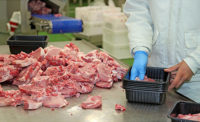Processors can’t take a hands-off approach to employee hygiene. The most important reason for good employee hygiene in meat and poultry plants is to protect against the transmission of foodborne illnesses from employees to product that is consumed.
In addition to protection against microorganisms, employee hygiene is very important for the image of a company.
“To see in a plant or see pictures of employees dressed in white with headgear, gloves and every indication of cleanliness, that has a very favorable impression of those that observe it,” says Norman Marriott, professor emeritus at Virginia Polytechnic Institute and State University, Blacksburg, Va.
Attention to employee hygiene also is important because the industry never knows when another pathogenic microorganism, from bacteria to viruses, might make an appearance.
“In the past when we started having more problems with Listeria monocytogenes and Escherichia coli O157:H7, [it showed] something that we need to be very cognizant of and diligent about — the possibility of emerging microorganisms that could appear,” Marriott says.
Keys to cleanliness
As a means of precaution measures in many counties, employees who handle food must be tested for tuberculosis and other disease causing microorganisms.
In some cases, employers are required not only to be tested, but also to have some sort of health certificate verifying healthy and safe food-handling practices.
In many processing plants, especially ready-to-eat facilities, employees must change clothes, including footwear, in a locker room to aid in cleanliness. Most processors require employees to wear headgear and netting to cover hair, including facial hair.
In addition to those steps, employees are required to wash hands before work. Processors use a variety of different washing facilities, from lavatories to mechanized hand-washers, in which employees insert their hands, and they are washed and sanitized.
Every company has different hand-washing techniques and protocols that are incorporated. Basically it involves steps to ensure the use of soap and rinsing followed by sanitizing, Marriott explains. The key is to make it easy for employees to wash hands, says Martin Bucknavage, senior food safety extension associate at Penn State Department of Food Science, University Park, Pa.
“Hand-washing station placement is key,” says Bucknavage. “Many processors place hand-washing and foot-washing units at entry points into processing areas, forcing employees to wash their hands and boots before entry into processing areas.”
Hand-washing units in processing areas should be strategically placed throughout the processing area, he adds.
“There should be separate units for those on pre-process side and the post-process side to prevent people from having to travel back and forth from one side of the operation to the other, thus minimizing the potential for cross-contamination,” Bucknavage explains. “They should be placed in close proximity to where workers are likely to have a higher need for more frequent hand washing.”
Hands-free operation of those stations is also helpful, but the hands-free device must work, Bucknavage cautions.
“I personally like foot-operated washing rather than electronically controlled, because I have seen the sensor devices not working properly,” he says. “When they do not work properly, busy people will not stand there and continue to move their hands around the sink and wait for it to start working, and we do not want people getting frustrated and heading back to work without washing their hands.”
The other key is committed, engaged management. Bucknavage says he has seen automatic sensors installed that send out an alarm when people leave the restroom without washing their hands.
“I guess that works, but I’d like to see a workforce that is tightly trained where employees do it automatically,” he says. “They have been drilled in hand-washing and understand the importance.
“These are the employees who police each other as well as visitors,” Bucknavage adds. “When you get people focused to do all the small things, they are less likely to take shortcuts on the big things.”
As far as gloves are concerned, the industry has different philosophies and requirements regarding the use of plastic gloves, Marriott says.
“It certainly makes a statement when employees wear plastic gloves, but one of the problems is … , if they don’t change them frequently, they can become soiled and the contamination would be similar to the hand,” Marriott adds. “Likewise, if the hands are washed and sanitized, then they are hygienically acceptable.”
Some companies also require a nose guard, which can prevent employees from sneezing on a product. Yet, wearing a nose guard also can harbor more microorganisms because the apparatus can trap the germs inside, Marriott explains. Changing footwear also becomes very significant to cleanliness.
“The reason that footwear is quite important is because of the contamination that shoes can bring into the plant,” Marriott explains. “After changing footwear — in most cases there would be some kind of rubber boots — many companies require their employees to go through either a foot sanitizer or some kind of a foam spray where it is sprayed on their feet. Not only do they change footwear, but their footwear is sanitized before entering the plant.”
Stepping up hygiene
Most of the technology that is used for employee hygiene has been available for several years, and more companies are going about incorporating it today.
Mechanized ways now are available to promote cleanliness, but supervision is still the best way to monitor that employee-hygiene protocols are being adhered, Marriott says.
Education is key, as is clear communication of protocols to employees, regardless of their primary language or education level.
“Many times if plants will go to the effort of educating their employees about the importance of personal hygiene, then they are more likely to follow it and there is less of a supervisory problem of making them do it,” Marriott says.






Report Abusive Comment